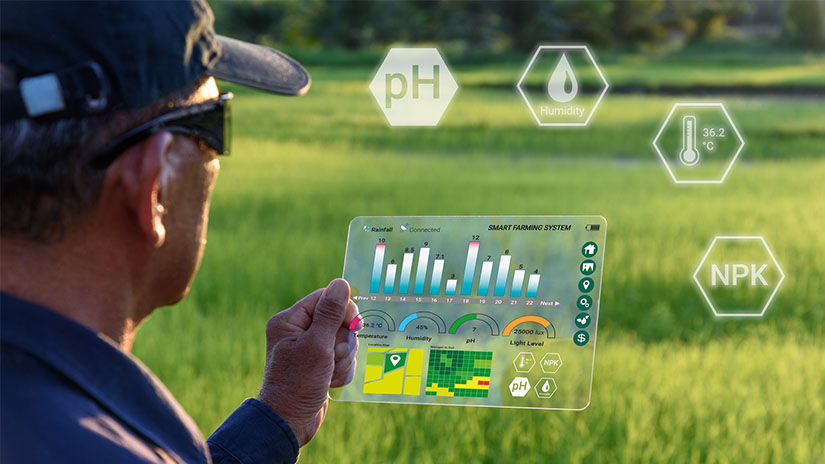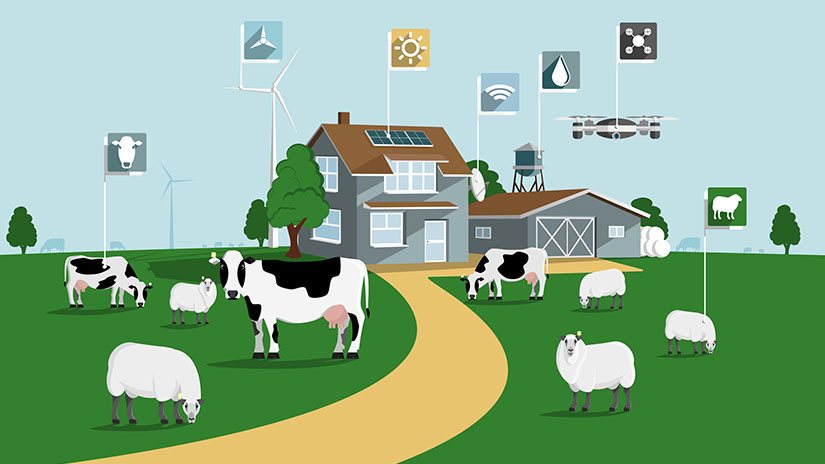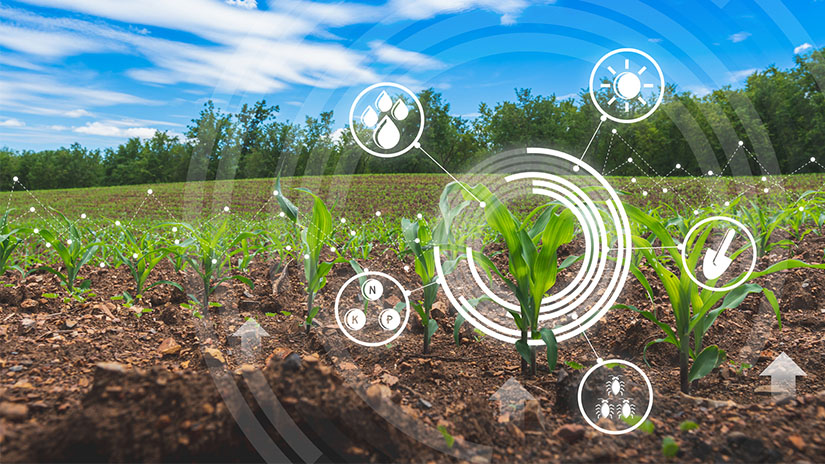By Udayan Joshi, Director of Solution Architecture, Global Social Innovation Business, Hitachi America, Ltd.; and M. Terry Coffey, Ph.D., Industry Expert; and Brad Howard, Ph.D., Industry Expert
Today, advances in agronomy combined with smart agriculture technology have improved crop yields and sustainability. Enhancements in animal husbandry technology, improved breeding, nutrition and disease management help ensure optimal growth and performance of livestock. In spite of these innovations, the agricultural industry still faces significant challenges in producing enough food and getting it safely to market. These include changing weather patterns, water shortages, urbanization, population growth, complex environmental regulations, and dwindling available agricultural land, among others. In addition, food waste is a significant drain on the global food supply. Food insecurity is still a worldwide problem, with 821 million people malnourished 1 and approximately one third of the food that’s produced being wasted.2 With the world’s population expected to grow to 9.6 billion by 2050, according to United Nations estimates,3 food security and malnourishment challenges could worsen. To feed this growing population, the agricultural industry will have to produce 70% more food than it’s currently producing4 and will need to deliver it more efficiently and safely to the end consumer. There is also an increasing focus on animal well-being, which can be improved by effectively tracking and monitoring animal behaviour, feed intake and early signs of illness or discomfort. The industry needs a holistic approach that can increase productivity while improving environmental impact, sustainability and efficient utilization of resources.
To succeed, the industry must make improvements at every point of the value chain — from production and harvest to transportation, distribution and storage — to optimize output and reduce waste. In addition to improvements across the individual functions of the value chain, digital technology enables enhanced integration across these silos of innovation. Digital technologies and the internet of things (IoT) are driving a transformation through smart agriculture solutions that help farmers do more with less. For example, sensors and other IoT-enabled devices gather volumes of critical data in real time. These devices include video solutions that gather data for animal monitoring, drones and robots that assess crop quality and growth, and more. New technologies are also being developed to enhance and automate processes traditionally performed by people, especially in food processing, where it is essential to prepare food products safely for storage and distribution to market. With IoT devices and agriculture automation, immense amounts of data can be collected quickly and accurately. The rapid analysis of this real-time data can then be used to make decisions faster, and to guide precise adjustments to operational processes. Additionally, data analytics can lead to the discovery of patterns and longer-term opportunities for fundamental optimization of these operational processes. When farmers have accessible, complete and accurate real-time data and analytics-driven insights, they can make informed decisions quickly on a broad level to drive improved outcomes in food production across every aspect of the agriculture ecosystem.

The opportunity to address the increasing demand for sustainable food production lies in integrating the silos of innovation across the agriculture value chain. The individual links in this chain include crop management, animal life cycle management, logistics and supply chain, processing facilities, environmental management, sustainability and more. At Hitachi, we call this the Internet of Living Things, an integrated ecosystem that uses digital technologies to implement smart farming systems reducing the overall cost of producing and delivering food to consumers while improving environmental sustainability and animal and worker well-being. Some smart farms now track and monitor livestock across geographically distributed operations using drones and sensors in combination with radio-frequency identification (RFID) tagging, Lidar and video cameras to keep track of the growth and health of the animals. That information could be integrated with other data, such as weather forecasts, feed and water consumption, and environmental conditions like temperature and humidity in the barns, to optimize animal health and growth. By integrating these systems, farms can ensure animal health, for example, by adjusting the operating parameters for equipment such as fans and ventilation controls.

A farm could also integrate and analyze data from weather predictions, animal growth and eating patterns to deliver predictive guidance for selecting the appropriate feed recipes. This can ensure that the farm is meeting the nutritional needs of its animals while at the same time reducing waste and improving efficiency. This approach would optimize resource utilization, environmental impact, waste management and supply chain efficiency. Over time, these analytics can drive cost-effective commodity procurement processes and improvements across the entire supply chain. The benefits of the connected value chain include better planning, scheduling and capacity management. In the U.S., farmers are less than 1% of the country’s population, and the agricultural industry is experiencing ongoing labor shortages.5 Technology will help fill that gap. Artificial intelligence and machine learning are providing increasingly sophisticated analytics that supports faster and better-informed decision-making. The Internet of Living Things helps farmers solve challenges such as:
At Hitachi, we work with our agriculture customers, blending solutions from our own portfolio and the broader technology ecosystem to drive the Internet of Living Things. As a trusted advisor to our customers and governments around the world, we anchor an ecosystem of innovative partners across the value chain to create and connect the technologies that improve food security and environmental sustainability. Through the Internet of Living Things, we can bring these solutions together in an integrated ecosystem that creates interconnected, sustainable, efficient and profitable agriculture systems. Smart agriculture is more than just farms or animals or food processing facilities. This is an initiative Hitachi is driving in support of our commitment to powering good in the world.

Across the globe, Hitachi is developing solutions and working with companies to use digital technologies in the agricultural industry to address the challenges of individual farms in a way that will benefit all of society. Here are a couple of examples. Meat & Livestock Australia. Australia is a leading exporter of beef, sheep, lamb and goat meat. Factors that impact one participant in Australia’s agriculture sector, such as severe weather or current market prices, can easily impact all participants. Hitachi is helping Australia’s meat industry transform its value chain through an integrated IoT digital strategy based on data-driven, cross-industry decisions.6 Our solution captures data at the micro level that can be rolled up to the macro level to create an integrated view of the industry as a whole and drive best practices that benefit every farmer through greater efficiency, productivity and quality. Maple Leaf Foods. Canada’s largest provider of prepared meats and poultry is Maple Leaf Foods. As the first major carbon-neutral food company in the world,7 Maple Leaf Foods is committed to both environmental sustainability and to creating efficient operations that maximize food production. Hitachi is helping Maple Leaf Foods meet these goals with myriad integrated digital technologies that deliver crucial insights for driving the best decision-making regarding every aspect of operations. Farming is a complex landscape with many stakeholders. Though there are exciting new possibilities for integrating digital technology into agriculture that will benefit both the individual farm and society, it will require careful planning. At Hitachi, we focus on co-creating best-of-breed solutions with our customers that meet their needs and those of everyone on the planet. In this way, we can help the agricultural industry achieve its goal of driving food security through supply chain integration ― and help put enough nourishing food on everyone’s table. If you are interested in learning more or starting a conversation about the Internet of Living Things, please visit the Social Innovation Business website. We look forward to connecting with you and discovering how Hitachi can help you.

Director of Solution Architecture, Global Social Innovation Business, Hitachi America, Ltd.
Udayan’s expertise is in applying digital technology capabilities to architect solutions that fulfill business requirements while delivering a positive social impact.
Udayan’s role as a digital solutions architect covers application of a wide range of technology areas including: IoT, Industrial IoT, Data Science, Block Chain and Video Analytics, across a wide range of application domains such as manufacturing, agriculture, transportation & mobility, telecommunications, automation and smart spaces.